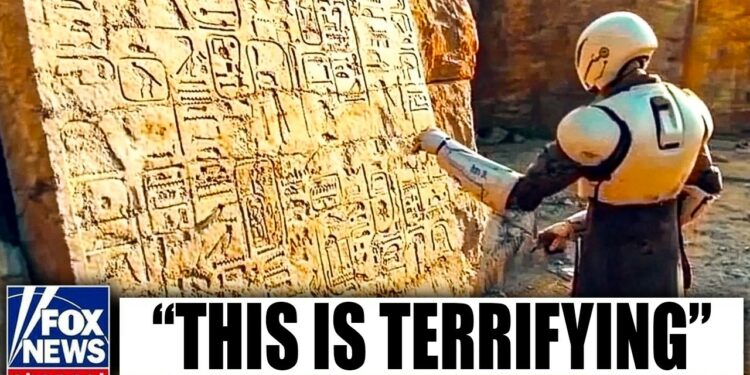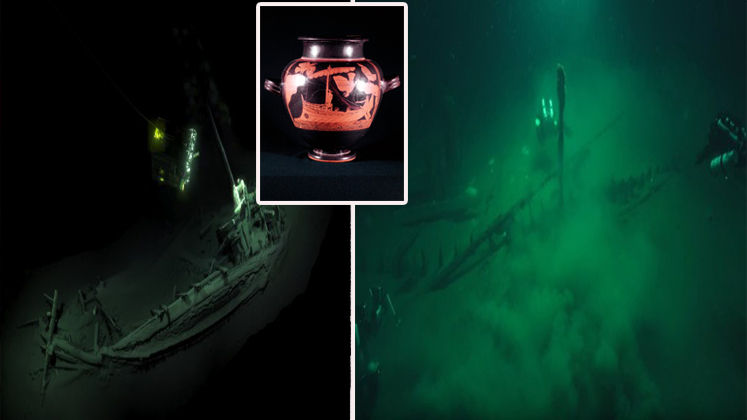Ancient scrolls, buried under volcanic ash during the eruption of Mount Vesuvius, are now being deciphered 2,000 years later, thanks to advancements in artificial intelligence. For centuries, these fragile remnants of lost civilizations have whispered secrets through time. Now, cutting-edge technology, powered by AI, is bringing them to light, revealing hidden words in dusty tomes, resurrecting faint inscriptions, and breathing life into silent scripts. Evidence of hand movements, sometimes with damage to nails and fingertips, hints at the physical toll of their creation. But are we unlocking vital wisdom or stirring something far more unsettling?
The Indus Valley Script
One of the greatest enigmas of the ancient world comes from the highly advanced Indus Valley civilization, which flourished over 4,000 years ago in what is now Pakistan and northwest India. This society built remarkably planned cities like Mohenjo-Daro and Harappa, with organized street grids, sophisticated drainage systems, and evidence of extensive trade. Yet, one critical aspect remains elusive: their script. Countless small seals, pottery shards, and baked clay tablets bear symbols that likely represent words or ideas, often in brief inscriptions of just a few characters. Scholars have debated for decades whether this script is a full-fledged written language, a proto-script for recordkeeping, or a mix of both.
Without a Rosetta Stone equivalent, traditional methods have stalled. However, recent computational approaches have identified repeating patterns, revealing a structured system that may have been used to track goods, record religious practices, or formalize social contracts. While the script remains undeciphered, these breakthroughs suggest the Indus people employed a consistent system, offering glimpses into their advanced society.
The Nazca Lines
Stretching across the arid plains of southern Peru, the Nazca Lines are monumental geoglyphs carved into the desert floor. From the ground, they appear as shallow trenches, but from above, they form intricate outlines of animals, plants, and geometric shapes. Created between roughly 500 BCE and 500 CE, these massive designs have fascinated explorers, archaeologists, and tourists for generations. With hundreds of shapes, including iconic figures like the hummingbird, spider, and monkey, the Nazca Lines are remarkable for their scale and number.
Though their exact purpose remains debated, many experts believe they held religious or ceremonial significance, possibly used in rituals to appeal to deities for rain or bountiful harvests in the water-scarce Nazca region. Recent advancements, including drones and high-resolution imaging, have uncovered previously unseen shapes and faint lines. Traces of offerings near some lines suggest a strong ritualistic element, offering insight into the spiritual life of the Nazca people. These discoveries highlight the ingenuity of a society that achieved such a large-scale project without modern tools.
The Ice Mummy of the Andes
High in the Peruvian and Argentinian Andes, researchers have discovered Inca mummies left on mountain peaks as part of sacred rituals. One of the most famous, the Ice Maiden, a young girl, was found in remarkable condition due to sub-zero temperatures that preserved her hair, clothing, and internal organs. These mummies are linked to the Inca practice of capacocha, a ceremony performed during significant events or to appease the gods. Children deemed physically perfect were chosen for these sacrifices, often placed at steep, inhospitable peaks alongside offerings like figurines and textiles.
While unsettling, these sacrifices were central to Inca beliefs, possibly ensuring the empire’s well-being or land fertility. Non-invasive techniques, such as careful imaging and light scanning, allow scientists to study these remains without damage. Analysis of the Ice Maiden’s stomach contents revealed her final meal, offering clues about the diet of high-status Incas. Her elaborate clothing and headgear underscore her ceremonial role. These frozen altars are poignant reminders of a culture that saw life, death, and nature as deeply intertwined with the divine.
The Scrolls of Herculaneum
In 79 CE, Mount Vesuvius erupted, burying Pompeii and Herculaneum under tons of ash. While Pompeii often steals the spotlight, Herculaneum holds a unique treasure: the Villa of the Papyri, home to hundreds—perhaps thousands—of delicate scrolls. Partially burned and carbonized by intense heat, these scrolls were unreadable for centuries, as unrolling them risked disintegration. They may contain lost works of Roman literature and philosophy.
Early attempts to open the scrolls often failed, with fragments crumbling to dust. Recent non-invasive techniques, such as advanced X-ray scanning and data analysis, have revealed faint traces of ink. Decoded portions discuss philosophical themes like pleasure, happiness, and scarcity, possibly linked to the Epicurean philosopher Philodemus or contemporaries. Each fragment feels like a conversation with ancient thinkers, a thrilling reminder that hidden knowledge can resurface with the right tools.
Ötzi the Iceman
In 1991, hikers in the Ötztal Alps, on the Austria-Italy border, discovered the frozen remains of a man who died over 5,000 years ago. Nicknamed Ötzi, this Copper Age individual was remarkably preserved, with intact skin, clothing, and organs. His attire—a cloak, leggings, and grass-stuffed shoes—along with tools like a copper axe, flint knife, and unfinished bow, paints a picture of a skilled survivor adept at agriculture and hunting.
Evidence suggests Ötzi met a violent end, with an arrowhead in his shoulder and a severe hand wound, possibly indicating an attack followed by a desperate escape to the mountains. Scientific analysis, including organ scans, revealed his last meal (ibex meat and grains) and health conditions like lactose intolerance. His tattoos, located near stressed joints, suggest prehistoric therapeutic or ritual practices. Ötzi’s story connects us to an individual from a world predating the pyramids, showing how ancient human stories can endure in glacial ice.
Pompeii’s Ancient Fast Food Joints
Pompeii is famous for its tragic end, but it also reveals a vibrant culture through its thermopolia—ancient fast food shops. These establishments featured colorful counters with earthenware jars (dolia) offering hot meals to go. With many residents living in cramped homes without kitchens, thermopolia were a convenient dining option. Counter paintings often depicted animals or ingredients, hinting at dishes like stews, salted fish, spiced wine, or lentils. A recently unearthed shop boasted murals of a dog, poultry, and a sea nymph, adding artistic flair to the dining experience.
Advanced techniques like ground mapping and short-range scans have helped locate these shops and analyze food residues, revealing traces of snails and wine grapes. These findings paint a lively picture of daily life in Pompeii, where people socialized, ran errands, and grabbed quick meals—much like today.
Mayan Glyphs
The ancient Maya civilization left behind stunning architecture, but their writing system, preserved on stone monuments, pottery, and bark-paper codices, is among their greatest achievements. Combining phonetic and logographic elements, these intricate glyphs puzzled scholars for centuries. Mid-20th-century breakthroughs revealed that glyph blocks often represent syllables, unlocking accounts of battles, treaties, dynasties, and tributes. Digital databases now accelerate transcription and comparison, illuminating Mayan mythology, historical events, and astronomical observations. These glyphs reveal a highly literate civilization that documented everything from daily affairs to cosmic cycles.
The Nebra Sky Disc
The Nebra Sky Disc, a bronze artifact about a foot in diameter, adorned with gold symbols of the sun, moon, and stars, may be one of the oldest representations of the night sky. Discovered in Germany and dated to around 1600 BCE, its gold inlays depict star clusters (possibly the Pleiades) and arcs marking seasonal horizons. This suggests Bronze Age societies were attuned to celestial cycles, using the disc for agricultural or religious purposes. Found with bronze swords and bracelets, it was likely a ritual offering. Advanced imaging confirms its authenticity and reveals design adjustments over time, bridging ancient mythic interpretations of the cosmos with modern scientific curiosity.
Austrian Roman Gladiator School
While gladiators are often associated with Rome’s Colosseum, a gladiator training school (ludus) was uncovered near Carnuntum in Austria, showing their value across the Roman Empire. This complex, with courtyards, sleeping cells, and practice areas, reveals intensive training in various fighting styles, from net-and-trident tactics to sword-and-shield combat. Geophysical surveys and artifacts like personal items and protective gear highlight a disciplined, communal lifestyle. This school underscores how Roman entertainment culture spread to distant provinces, reflecting ambition far from the empire’s heart.
Viking Longships
Viking longships, with their sleek design and shallow drafts, were technological marvels that enabled exploration, trade, and raids across vast distances, from Scandinavia to Russia, the British Isles, and beyond. Their speed and versatility allowed navigation of oceans and rivers, guided by the sun, stars, and possibly sunstones. Ship graves, discovered through farmland scans, reveal construction methods and daily life through artifacts like cooking pots and weapons. Each find deepens our appreciation for a culture that thrived on exploration and connectivity.
Tutankhamun’s Meteorite Dagger
Among the treasures in King Tutankhamun’s 14th-century BCE tomb is an iron dagger forged from meteoritic material, a rarity before the Iron Age. Its high nickel content confirms its cosmic origin, and its gold hilt and patterned blade showcase advanced craftsmanship. In ancient Egypt, “metal of heaven” was seen as a divine gift, linking the young king to celestial forces. Non-invasive X-ray fluorescence analysis verifies its origins, highlighting how the cosmos shaped early religious beliefs.
Dwarka
Dwarka, the legendary city of Lord Krishna in Hindu texts, was said to have sunk beneath the sea. Underwater structures off Gujarat’s coast, including stone blocks and pottery, suggest a historical basis for the myth. Submersible cameras and sonar scans map these submerged ruins, with carbon dating hinting at a timeline aligning with Krishna’s era. While debate continues, Dwarka blends mythology and archaeology, revealing a vibrant coastal community lost to the sea.
Pompeii Graffiti
Pompeii’s graffiti, preserved by volcanic ash, offers a glimpse into daily life through love notes, election notices, and playful insults—ancient social media etched on walls. Messages range from complaints about stolen cloaks to endorsements of local candidates. Advanced photography and scanning reveal faint inscriptions, like “Celadus the Thracian gladiator, heartthrob of all the girls,” showcasing humor and passion in a city frozen in time.
The Giza Pyramids
The Great Pyramid of Giza, built for Pharaoh Khufu around 2500 BCE, was the tallest human-made structure for nearly four millennia. Its massive limestone and granite blocks, fitted with precision, raise questions about ancient engineering. Four main chambers and sealed passages fuel speculation about hidden voids, with scanning projects detecting possible undiscovered corridors. The pyramids reflect the monumental organization of labor, logistics, and religious beliefs in ancient Egypt.
The Sutton Hoo Ship Burial
At Sutton Hoo, England, a 7th-century Anglo-Saxon ship burial, likely for King Raedwald, revealed lavish grave goods, including a reconstructed helmet with intricate animal motifs. Byzantine bowls and gold buckles indicate far-reaching trade. Scanning tools have refined the burial’s layout, showing a society blending pagan and Christian traditions, seeking a grand journey to the afterlife.
The Dead Sea Scrolls
In 1947, a Bedouin shepherd discovered ancient manuscripts in Qumran’s caves, dating from the 3rd century BCE to the 1st century CE. These scrolls, including Hebrew Bible portions and apocryphal works, illuminate Second Temple Judaism and early Christianity. Multispectral imaging enhances faded texts, revealing apocalyptic visions like the War Scroll and confirming the stability of biblical texts like Isaiah.
The Oxus Treasure
Found near the Oxus River, this hoard of 180 gold and silver artifacts from the Achaemenid Persian Empire showcases intricate bracelets, plaques, and coins blending Persian, Greek, and local styles. X-ray fluorescence verifies their origins, highlighting Central Asia’s role as a vibrant cultural crossroads along the Silk Road.
The Siberian Unicorn
The “Siberian unicorn,” a rhinoceros species (Elasmotherium sibiricum), roamed Eurasia with a large forehead horn. A skull dated to 29,000 years ago shows it coexisted with humans. Tooth wear and radiocarbon dating reveal its diet and extinction timeline, suggesting folklore about unicorns may stem from real encounters, blending myth with natural history.






















